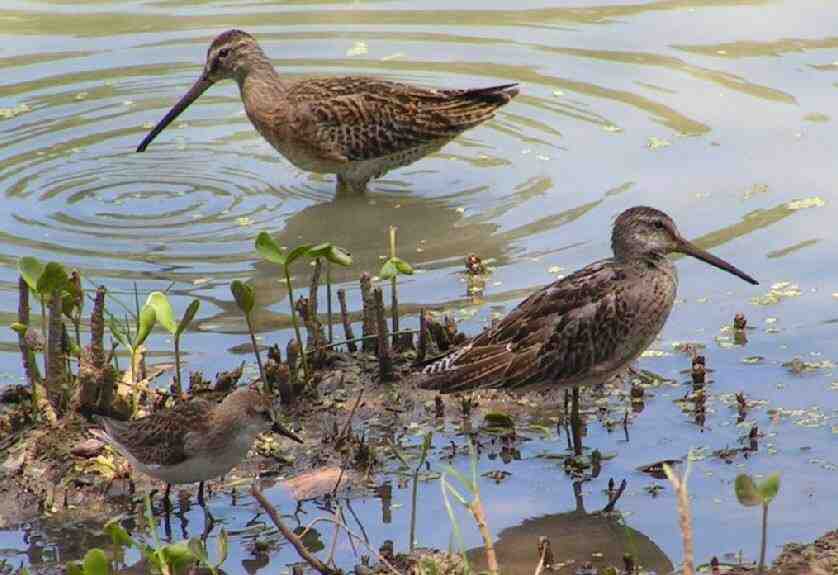Limnodromus semipalmatus
IUCN
LCBasic Information
Scientific classification
- name:Limnodromus semipalmatus
- Scientific Name:Limnodromus semipalmatus,Asian Dowitcher, Asiatic Dowitcher,Limnodrome semipalmé
- Outline:Wading birds
- Family:Charadriformes S.family Hemiphalus
Vital signs
- length:31-36cm
- Weight:165-245g
- lifetime:10-15
Feature
It is stout and has a beak like a snipe. When breeding, the underbody is light red, the waist and back are white.
Distribution and Habitat
Travellers: Kenya, Sri Lanka, Yemen.
It breeds in northeastern Inner Mongolia and Heilongjiang in China, passing through Jilin, Hebei, and the middle and lower reaches of the Yangtze River during migration to Fujian, Guangdong, and Hong Kong. I occasionally pass through Taiwan.
It mainly inhabits lakes, rivers and coastal grasslands and marshes. In winter, it is mainly in the coastal tidal stream area and estuarine bar.
Appearance
The half-webbed snipe has a brown-red head and neck, and a black stripe through the eyes, extending to the eye first. There is a dense black stripe from the forehead to the top of the head, forming a brown-red brow stripe on both sides; Posterior neck with black longitudinal stripe; Reddish brown scarlet, broad plumage. Black central longitudinal spot. Shoulder feathers, medial secondary feathers and small coverts with gray feather margin; Lower back and waist white, with black central stripe; The upper tail cover with black and white stripes; The longer tail is covered with brown feathers. The tail has alternating black brown and white markings. The end brown stripes are wide and fuzzy. Small wing coverts black brown; The rest of the cover is grayish brown with white feather margin; Feather brown, feather shaft white. The outer 5 primary flight feathers have long white wedges on the inside, both sides of the inside; Lateral secondary feathers grayish brown, with broad white feather ma
Details
The semi-webbed snipe (ban p Giryu), also known as Asian Dowitcher, is a small wading bird.

They live alone or in small groups. Sex is timid and alert. It feeds mainly on insects, insect larvae, worms and mollusks. Often in the lake, river banks, ponds and swamps and coastal tidal areas of sand and mud foraging. The mouth is often inserted into the mud to the base of the mouth.
The half-webbed snipe is a summer migrant and traveler in China. Spring passes through China from March to May and autumn passes through China from August to October. They often migrate in small groups.
The breeding season of the half-webbed snipe is from May to July. The mate is one female and one male. They often nest together in small groups. The location of the nest is not fixed and changes from year to year. They usually nest near water or in grass on the ground not far from water. They also nest on small mounds in the marsh, but still hide under the grass. The nest is filled with grass leaves and grass stems. The size of the nest is 12-16 cm in diameter. 3 to 5 cm deep. There are usually three eggs laid per litter. Sometimes as few as two and as many as four. The color of the eggs is sandy yellow, earth, olive, sandy brown or brown, with brown or reddish-brown spots; The egg is pear-shaped and is 40-56 x 29-35 mm in size. The weight is 22-33 grams. The male and female incubate the eggs in turn. Incubation period is 19-24 days.
Only the half-webbed snipe is found to breed in Siberia, Mongolia and north Northeast China. Wintering occurs in Thailand, Myanmar, India, Singapore, Philippines, Malaysia and Indonesia. It is rare in the wild. In 1986, the largest populations were 3,800 and 4,000 individuals. It is listed in the International Committee for the Conservation of Birds (ICBP) Red Book of the World's Endangered birds. Hence the need for strict protection.
It was listed in the List of Land Wild Animals under State Protection that are beneficial or have important economic and scientific research value (Item 148) issued by the State Forestry Administration of China on August 1, 2000. It is listed as a rare species in the "China Red Book of Endangered Animals · Birds".
Listed in the International Union for Conservation of Nature Red List of Threatened Species (IUCN) for 2016 ver 3.1 - Near Threatened (NT).
Listed in China's "National Key Protected Wildlife List" (February 5, 2021) Level 2.
Protect wild animals and eliminate wild meat.
Maintaining ecological balance is everyone's responsibility!








